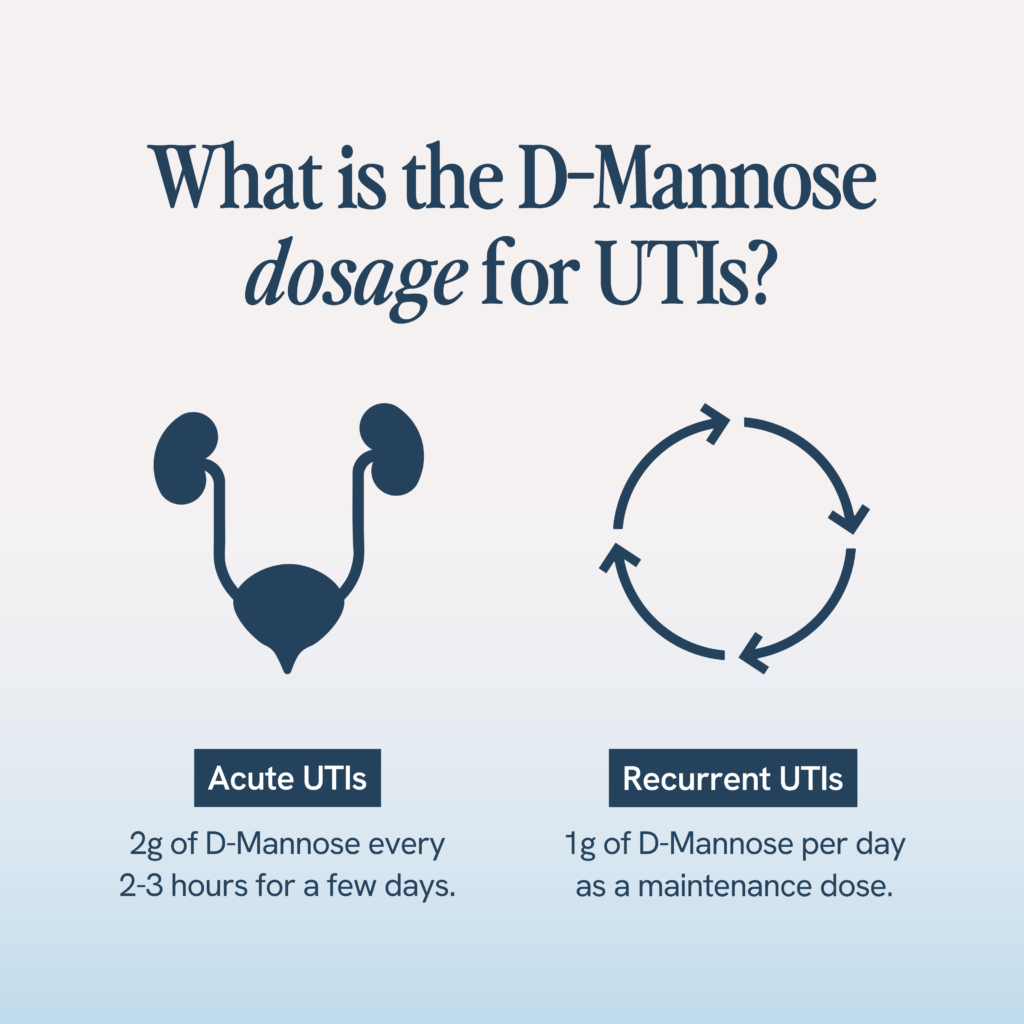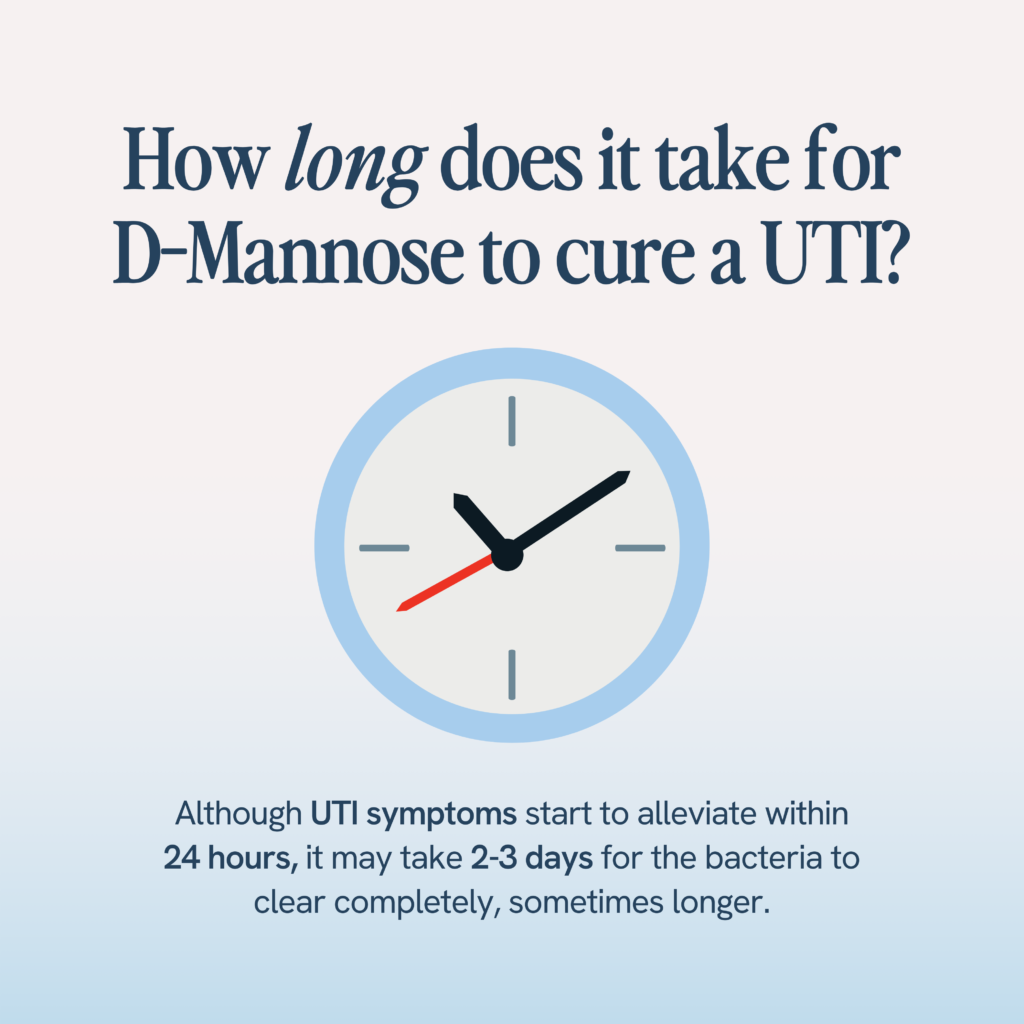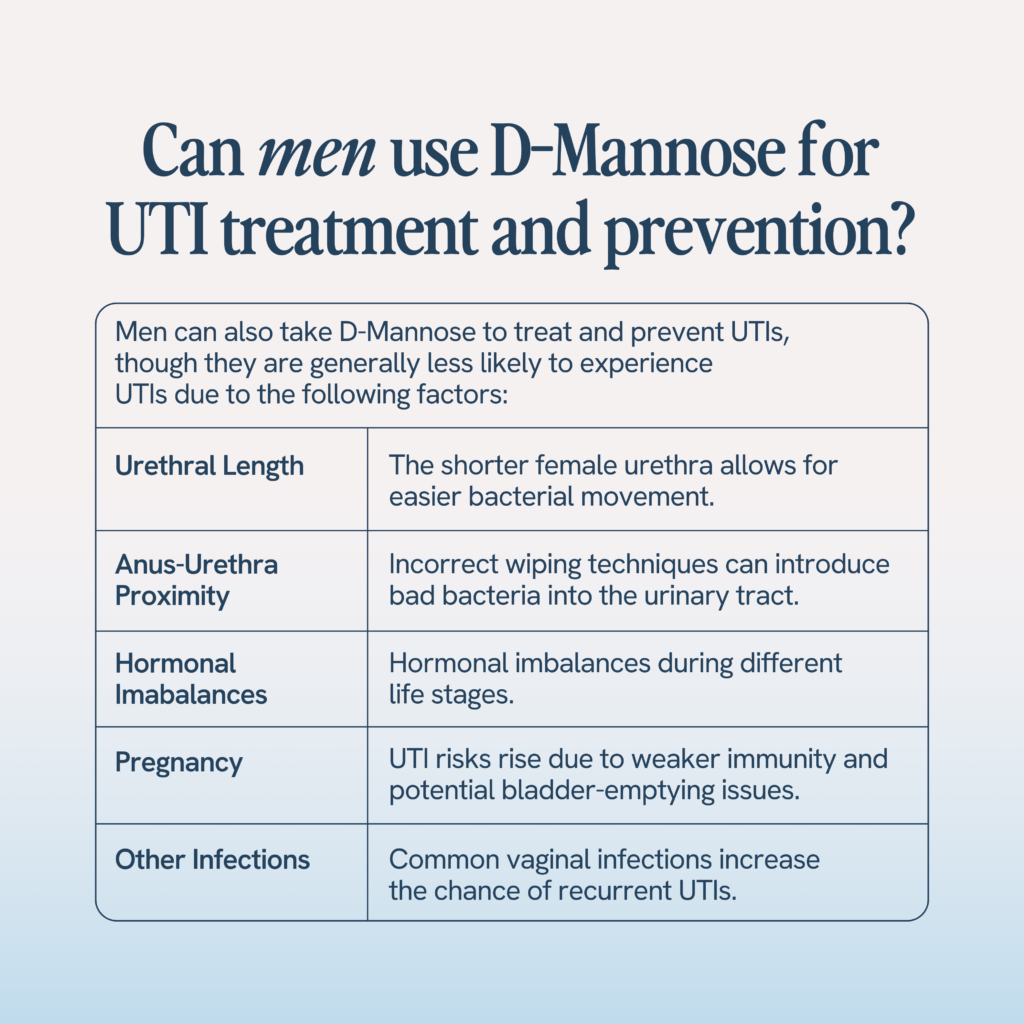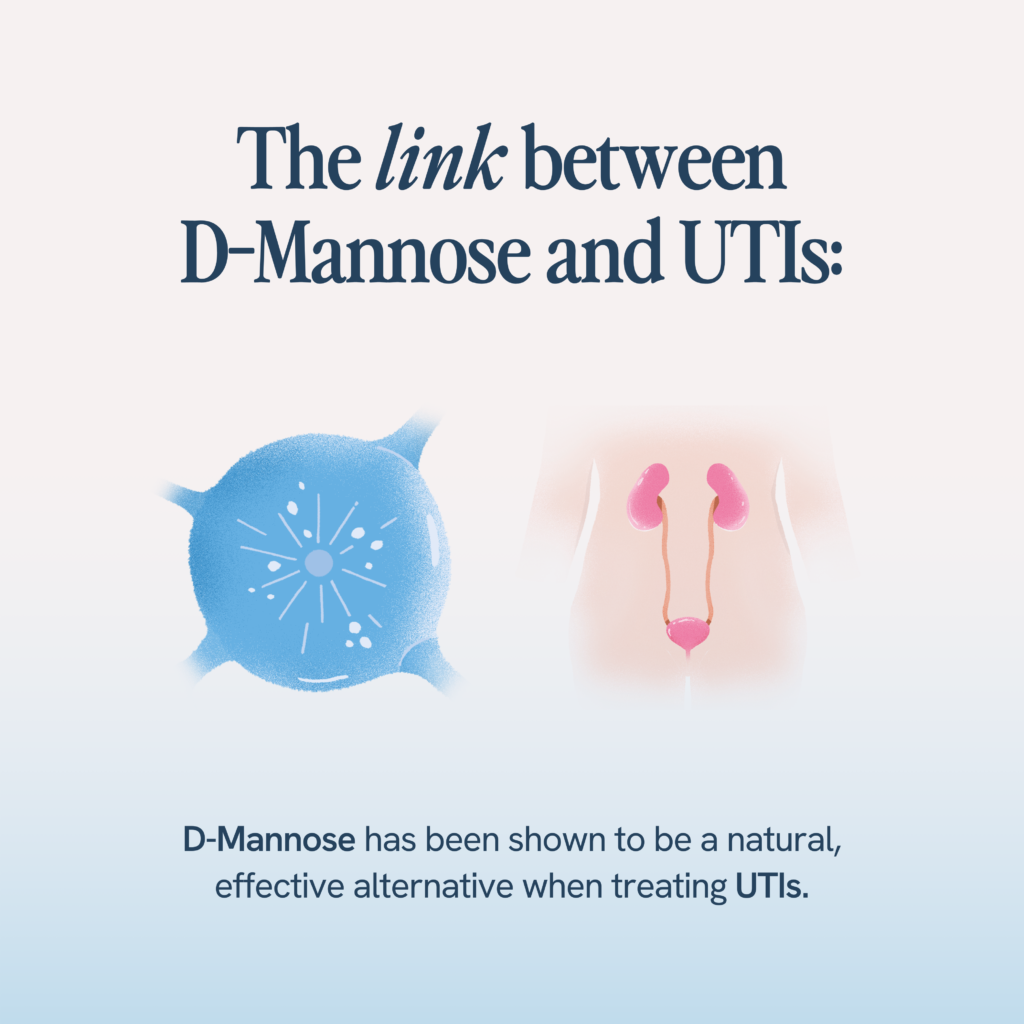- D-mannose is a naturally occurring simple sugar found in fruits like cranberries, oranges, and peaches.
- Multiple studies and clinical trials have found that D-Mannose is an effective alternative to treating UTIs compared to antibiotics.
- D-Mannose works by bonding with the UTI-causing bacteria, preventing adhesion to the walls of the urinary tract, vagina, and bladder.
- When taking D-Mannose, it is essential to follow the recommended dosage instructions, which may vary depending on whether you are using D-Mannose for UTI treatment or UTI prevention.
- While D-mannose is generally considered safe, it can potentially cause mild gastrointestinal symptoms and other rare side effects.
- Bacterial vaginosis (BV) affects over 21 million US women annually, resulting from an imbalance in the vaginal microbiome that favors harmful bacteria.

Millions of people every year struggle with recurrent urinary tract infections (UTIs), and if you’re reading this right now, we’re guessing you might be one of them. If so, you’ve come to the right place.
We know recurrent UTI sufferers aren’t just seeking relief from the burning while urinating or the frequent urge to urinate but relief from the frustration that comes with feeling trapped in a cycle you don’t know how to break free from.
Traditionally, antibiotics have been the go-to treatment for UTIs, but when used too frequently, they can lead to antibiotic resistance, rendering them ineffective. That’s why more and more focus is being given to natural remedies for treating recurring UTIs.
And in the natural remedy space, one supplement stands out: D-Mannose. Multiple studies, clinical trials, and systematic reviews have demonstrated its efficacy as an antibiotic alternative when treating UTIs. But is it right for you? That’s what we’re going to dive into here. We’ll discuss what D-Mannose is, what the science says, and how you might incorporate it into your routine to improve your quality of life.
What is D-Mannose?

Basically, D-Mannose is a naturally occurring sugar. It’s found most commonly in fruits, particularly:
- Cranberries
- Apples
- Oranges
- Pears
- Peaches
Despite being a simple sugar, D-mannose is not absorbed by the body as quickly as other forms of sugar, so it does not significantly alter blood sugar levels.
Interestingly, the way D-Mannose converts to glucose specifically also allows it to act as a prebiotic, which aids the growth of good bacteria within the vaginal flora, which can help address bacterial vaginosis or BV. We aren’t going to talk more about BV in this specific post, but we do have one you can read here that dives into this super common bacterial infection and how to treat it.
Here, we’re focusing on D-Mannose as an alternative treatment to UTIs. And what makes D-Mannose so attractive when it comes to UTIs is the way it interacts with E. coli, the primary bacteria responsible for 85% of UTIs. One pilot study from 1983 found that D-Mannose actually stops E. coli from attaching itself to the urinary tract, preventing infection. D-mannose does this by binding to the UTI-causing bacteria, and this adhesion allows the bacteria to be absorbed by the bloodstream, filtered by the kidneys, and expelled through the urine.
Especially when compared with antibiotics, D-Mannose is also favored for its rapid excretion. It doesn’t accumulate in the body, so unlike antibiotics, it doesn’t lead to as many side effects.
What is the effect of D-Mannose on UTIs?

As mentioned above, D-Mannose has been shown to effectively treat and prevent UTIs by binding to UTI-causing bacteria like E. coli. One In Vitro study observed that D-Mannose captures the attention of the pili, also known as the “fingers” of the E. coli. These “fingers” grab onto the D-Mannose instead of the urothelium or the urinary tract wall lining. From there, it is brought into the bloodstream, filtered by the kidneys, and flushed from the body entirely via urine. In fact, a study focusing on the efficacy and safety of oral D-mannose for UTIs in adult women revealed that 90.7% of the participants experienced symptom improvement within three days of treatment initiation.
Can D-Mannose help treat Bacterial vaginosis, too?
Bacterial vaginosis or BV is an infection that is caused by an imbalance of the bacterial flora in the vagina. Oftentimes, an active BV requires the use of antibiotics. Preventing future infections, on the other hand, requires rebalancing the natural flora and increasing the overall number of good bacteria or probiotics to fight off the bad. This is where D-Mannose can be helpful.
D-Mannose converts to glucose in the body and becomes a prebiotic. Prebiotics are food for probiotics. So if you are eating yogurt or taking a daily probiotic to try to prevent BV infections, D-Mannose can make those probiotics more likely to populate within your gut.
If you want more ideas about how you can treat and prevent BV naturally, you can read our blog all about it here.
Are there other benefits to taking D-Mannose?

D-mannose has been shown to support gut health by promoting the proliferation of beneficial gut bacteria. It also possesses anti-inflammatory properties and may bolster a healthy immune system.
The effects of D-Mannose can also be amplified when combined with complementary ingredients. When taken with cranberry extract, for example, D-Mannose is even more effective in treating UTIs. This is because cranberry has been shown to suppress E. coli’s gene expression, which can also prevent its growth and adherence.
Who can benefit from D-Mannose?

Anyone who struggles with urinary tract infections, particularly those with recurrent urinary tract infections, can benefit from taking D-Mannose.

Certain risk factors put you more at risk for contracting a UTI, though. If you have one or more of these, D-Mannose may be the right move for you.
- Multiple sex partners. Hey, love is love, but the facts are also the facts. And being sexually active with numerous partners exposes you to more potential bacteria and pathogens.
- Previous UTIs. E. coli from past infections can lay dormant in your biofilm and reactivate, causing a new infection.
- Diabetes. Those with type 1 and type 2 diabetes have heightened UTI risk due to generally lower immunity and reduced levels of the antimicrobial peptide psoriasin.
- Immune system variations. Whether you are immunocompromised or have an overactive immune system, both can result in more frequent UTIs.
- Urinary catheters. Catheters can inadvertently introduce bacteria into the urethra. Even in sterile conditions, the risk of catheter-associated UTIs (CAUTIs) is as high as 10% daily.
- Kidney stones. Any urinary tract blockage can cause bacterial buildup, resulting in UTIs.
- Hormonal imbalances. These can be caused by pregnancy, menopause, and contraception methods, and all increase your risk of UTI.
- Surgery. Especially if the procedure involves the lower urinary tract, surgery can introduce bacteria, leading to UTIs.
How can I add D-Mannose to my routine?

Like we mentioned at the top, D-Mannose is a naturally occurring sugar found in fruits like apples, oranges, and peaches, as well as in ground coffee beans and baker’s yeast.
But if you are suffering from recurrent UTIs, getting a clinically proven dosage of D-Mannose through fruits and coffees will prove quite tricky, which is why most people opt for D-Mannose supplements. D-Mannose supplements are available as capsules and as powders. Many are combined with cranberry or vaginal probiotics.
I think I have a UTI. Should I take D-Mannose right away?

If you ever suspect you have a UTI, the first thing you should do is make an appointment with your healthcare provider or gynecologist. Even if you have experienced a UTI in the past, the symptoms of a UTI, like frequent and painful urination, abnormal-smelling urine, and cloudiness or traces of blood in your urine, are also symptoms of yeast infections or bacterial vaginosis. You can even be experiencing several of these infections at the same time. That’s why it’s so important to call your healthcare provider before beginning any kind of treatment. They will test your urine and confirm your diagnosis. They may also ask you about other symptoms you may be experiencing, like nausea, fever, or chills, to determine if the UTI is uncomplicated or complicated.
Once you have a diagnosis, though, you should definitely discuss a treatment alternative like D-Mannose with your doctor, especially if you are hoping to avoid antibiotics or have used antibiotics in the past with no long-term success.
If antibiotics are unavoidable, you can still take a D-Mannose supplement, like Happy V’s D-Mannose & Cranberry, in conjunction with an antibiotic for a more effective treatment.
One word of advice if you are using D-Mannose to help treat an active UTI infection: drink plenty of water. Remember, D-Mannose helps your body flush out harmful bacteria, and drinking lots of water will make it easier for your body to do that.
Is D-Mannose a safe alternative to antibiotics?
The science behind D-Mannose as an alternative to antibiotics is still emerging.
The most referenced study regarding the effectiveness of D-Mannose for treating UTI symptoms came in 2013. In this study, 308 women were split into three groups, one taking an antibiotic, another taking two grams of D-Mannose, and a final taking a placebo. The results showed that D-Mannose worked just as well as the antibiotic at preventing UTIs over six months.
In another study from 2014, D-Mannose was directly compared to antibiotics and found that D-Mannose was able to reduce UTI symptoms in women with an active infection. It was also more effective than antibiotics in preventing additional infections, like yeast infections.
These studies are promising — really promising! But more rigorous studies need to be done to say conclusively that it is a true alternative to antibiotics. However, if you are wanting to avoid antibiotics for your UTI, talk to your doctor when you go in for a diagnosis. They will decide if D-Mannose is safe to try and also give you signs to look for that tell you D-Mannose alone is not enough and antibiotics are needed.
What is the D-Mannose dosage for UTI?

The recommended D-Mannose dosage depends on whether you are trying to treat an active infection or prevent a future one.
For acute UTIs, taking 2g of D-Mannose every 2-3 hours is often recommended. This will help your body quickly eliminate the bacteria causing the infection. After a few days, once symptoms subside, you can gradually reduce the dose.
If you have struggled with recurrent urinary tract infections and want to prevent future infections, a lower maintenance dose of 1g per day is sufficient. Some people take 1 single daily dose of D-mannose, while others divide the 1g into smaller doses taken throughout the day to maintain a consistent level of D-mannose in your system.
It’s always a good idea, though, to read the instructions for your specific D-Mannose supplement. These instructions will specify the recommended dosage, frequency of use, and any additional guidelines for proper administration. Following brand-specific instructions will help keep you safe while also ensuring maximum efficacy.
How long does it take for D-Mannose to cure a UTI?

Research shows that women with active UTIs started to see results within 24 hours of taking D-Mannose. Just be aware that relief from symptoms, while very much welcome, is not a sign that the infection is gone. Although UTI symptoms start to alleviate within 24 hours, it may take 2-3 days for the unwanted bacteria to clear completely; for some, it can be even longer.
If you have been taking D-Mannose for UTI treatment and symptoms are not improving, or you start to experience nausea, vomiting, or chills, call your doctor immediately, as these can be signs the infection has spread to the bladder walls or beyond.
Can men use D-Mannose for UTI treatment and UTI prevention?

Yes, men can also take D-Mannose to treat and prevent UTIs, though men are generally less likely to experience UTIs, especially recurrent ones.
There are lots of reasons for this discrepancy, including:
- Urethral Length: The shorter female urethra allows for easier bacterial movement.
- Anus-Urethra Proximity: E. coli presence in feces paired with incorrect wiping techniques can easily introduce the bacteria into the urinary tract.
- Hormonal Imbalances: For instance, reduced estrogen during menopause affects the vaginal walls and flora, increasing UTI susceptibility.
- Pregnancy: UTI risks rise due to weaker immunity and potential bladder-emptying issues.
- Other Infections: Common vaginal infections increase the chance of recurrent UTIs.
Is D-Mannose safe?

Long story short, yes. Multiple studies have shown that the use of D-Mannose is well-tolerated by both adults and children when consumed orally.
It is also typically considered safe for those who are pregnant, which is great since you are more prone to UTIs during pregnancy. But as with any new supplement, while you’re pregnant or breastfeeding, it’s best to talk to your doctor first so they can screen for risk factors that may make it less safe.
Supplement manufacturers have stated that possible side effects of too much D-Mannose may include:
- Diarrhea or loose stools
- Bloating
- Kidney damage, though this is found only in extremely high doses
However, unlike antibiotics, D-Mannose does not lead to any antibiotic resistance. And unlike antibiotics, D-Mannose does not kill good bacteria along with bad. It targets the harmful, UTI-causing pathogens but leaves the rest of the microorganisms in the vaginal flora unharmed.
How do I choose the right D-mannose supplement for UTIs?

This is a good, important question. Despite being so popular, dietary supplements are not regulated by the FDA, so it’s important to know what to look for in a supplement and how to know you are getting yours from a reputable source.
First things first, make reading labels a rule of thumb before you buy any dietary supplement. Check the ingredient label to ensure that your D-mannose is free from additives or preservatives.
Other than that, the exact kind of supplement you choose might come down to which form is most convenient, whether that’s a powder, a capsule, or a tablet. All of these forms are usually effective, but many find the powder the easiest to take since it can be mixed in with water or any other beverage.
Check out Happy V Cranberry and D-Mannose for a product made with clinically proven ingredients proven to alleviate the symptoms of UTIs
If you do choose to get your D-Mannose supplements from Happy V — and we hope you do — know that both our D-Mannose capsule and D-Mannose powder are free from additives, preservatives, and other harmful ingredients. In addition to this, our Cranberry Urinary Defense utilizes the only patented D-Mannose on the market: Uclear. The D-Mannose we use in our products is manufactured in our FDA-registered facility and is a regulated substance.
Who shouldn’t take D-Mannose?
It’s always a good idea to talk to your doctor before taking any new supplement, even if that supplement is natural and has promising science like D-Mannose.
If you are diabetic, prediabetic, or insulin-sensitive, you especially want to your doctor about D-Mannose before taking it because D-Mannose is a simple sugar. Like we said at the top, it does behave in your body differently than simple sugars like glucose and generally does not lead to spikes in blood sugar, but still, it’s better to be safe with certain preexisting conditions.
Besides D-Mannose, how can I prevent recurrent urinary tract infections?

Another excellent question. If you are struggling with recurrent UTIs, you may want to look into more significant lifestyle changes, along with D-Mannose, to break the cycle once and for all. A few things to consider:
- Avoid multiple sex partners. Like we said, being sexually active with multiple partners exposes one to a variety of microbiomes that could contain E. coli and other harmful bacteria.
- Avoid spermicides. The chemicals in spermicides can upset your vaginal pH balance, fostering an environment conducive to harmful bacteria. Opt for another form of birth control, like latex-free condoms.
- Check your wiping technique. Because, yes, there is a right way to wipe your butt. Wiping from back to front risks introducing fecal residue and bacteria into the vagina and urethra, enhancing the likelihood of UTIs.
- Manage preexisting conditions. If you are dealing with diabetes, kidney stones, menopause, or pregnancy, understand how these impact your UTI risk, make a management plan with your doctor, and stick to it.
Learn about our D-Mannose and Cranberry Supplement, with clinically proven ingredients.
- A-
- A+
Learn about our D-Mannose and Cranberry Supplement, with clinically proven ingredients.






